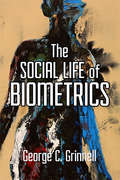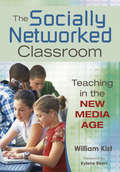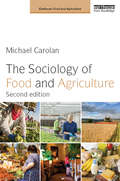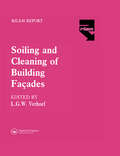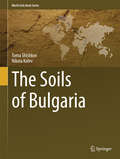- Table View
- List View
The Social Dimensions of the Circular Economy (Greening of Industry Networks Studies #10)
by Lucila Maria de Souza Campos Diego A. Vázquez-BrustThe main theme of this book is the social dimension of the circular economy (CE). This book’s objective is to provide a foundation for the discussion of social aspects of CE that also allows the integration of CE with the UN SDGs. The circular economy is increasingly becoming the consensual pathway for a transition towards sustainable production and consumption that balances the economic and ecological pillars of sustainable development. However, researchers have noted that the social dimension of sustainable development is noticeable missing or, at best, weakly developed in CE ideas and frameworks (Sehnem et al., 2019). The main argument of this book is that CE research and practice needs to embrace its social impacts, not only in terms of understanding and avoiding negative social impacts but also in terms of exploring the potential that CE models have for addressing social challenges.
The Social Life of Biogas: Biogas Users and Their Innovations in Indonesia
by Meredian AlamThis is the most comprehensive book discussing the impact of renewable energy transition by engaging local narratives, and combining this with the domestication of technology theory. Addressing a specific concern, the discussion considers the development of household biogas from an interdisciplinary sociological perspective and addresses the success factors for the implementation of biogas policy on the household level in Indonesia. Drawing upon extensive ethnographic fieldwork in a rural Indonesia, this book explores the interactive process of social and technological innovation from a user perspective. Their social interactions with wider stakeholders such as biogas technology trainers, laborers, construction partner organizations, and fellow users are examined. The author sheds light on emerging evidence around biogas sustainability by engaging a unique interdisciplinary framework that combines aspects of both sociology and engineering. Offering a unique insight, this book is relevant for social scientists, postgraduate students, social workers, environmental activists, communication experts, and engineers working across aspects of renewable energy development. They will gain new interdisciplinary insights and applicable approaches to building household biogas by actively engaging the users.
The Social Life of Biometrics
by George C GrinnellIn The Social Life of Biometrics, biometrics is loosely defined as a discrete technology of identification that associates physical features with a legal identity. Author George Grinnell considers the social and cultural life of biometrics by examining what it is asked to do, imagined to do, and its intended and unintended effects. As a human-focused account of technology, the book contends that biometrics needs to be understood as a mode of thought that informs how we live and understand one another; it is not simply a neutral technology of identification. Placing our biometric present in historical and cultural perspective, The Social Life of Biometrics examines a range of human experiences of biometrics. It features individual stories from locations as diverse as Turkey, Canada, Qatar, Six Nations territory in New York State, Iraq, the skies above New York City, a university campus and Nairobi to give cultural accounts of identification and look at the ongoing legacies of our biometric ambitions. It ends by considering the ethics surrounding biometrics and human identity, migration, movement, strangers, borders, and the nature of the body and its coherence. How has biometric thought structured ideas about borders, race, covered faces, migration, territory, citizenship, and international responsibility? What might happen if identity was less defined by the question of “who’s there?” and much more by the question “how do you live?”
The Social Life of Connectivity in Africa
by Mirjam De Bruijn Rijk Van DijkThe rapid increase in adoption of modern 'connective' technologies like the mobile phone has reshaped the social landscape of Africa. This book examines the myriad possibilities that the post-global moment offers African societies to develop and to relate, offering profound new insights into the processes of globalization.
The Social Life of DNA
by Alondra NelsonThe unexpected story of how genetic testing is affecting race in AmericaWe know DNA is a master key that unlocks medical and forensic secrets, but its genealogical life is both revelatory and endlessly fascinating. Tracing genealogy is now the second-most popular hobby amongst Americans, as well as the second-most visited online category. This billion-dollar industry has spawned popular television shows, websites, and Internet communities, and a booming heritage tourism circuit.The tsunami of interest in genetic ancestry tracing from the African American community has been especially overwhelming. In The Social Life of DNA, Alondra Nelson takes us on an unprecedented journey into how the double helix has wound its way into the heart of the most urgent contemporary social issues around race.For over a decade, Nelson has deeply studied this phenomenon. Artfully weaving together keenly observed interactions with root-seekers alongside illuminating historical details and revealing personal narrative, she shows that genetic genealogy is a new tool for addressing old and enduring issues. In The Social Life of DNA, she explains how these cutting-edge DNA-based techniques are being used in myriad ways, including grappling with the unfinished business of slavery: to foster reconciliation, to establish ties with African ancestral homelands, to rethink and sometimes alter citizenship, and to make legal claims for slavery reparations specifically based on ancestry.Nelson incisively shows that DNA is a portal to the past that yields insight for the present and future, shining a light on social traumas and historical injustices that still resonate today. Science can be a crucial ally to activism to spur social change and transform twenty-first-century racial politics. But Nelson warns her readers to be discerning: for the social repair we seek can't be found in even the most sophisticated science. Engrossing and highly original, The Social Life of DNA is a must-read for anyone interested in race, science, history and how our reckoning with the past may help us to chart a more just course for tomorrow.From the Hardcover edition.
The Social Metabolism of Spanish Agriculture, 1900–2008: The Mediterranean Way Towards Industrialization (Environmental History #10)
by Manuel González de Molina Juan Infante-Amate David Soto Fernández Gloria Guzmán Casado Eduardo Aguilera Fernández Jaime Vila Traver Roberto García RuizThis open access book provides a panoramic view of the evolution of Spanish agriculture from 1900 to the present, offering a more diverse picture to the complex and multidimensional reality of agrarian production. With a clear transdisciplinary ambition, the book applies an original and innovative theoretical and methodological tool, termed Agrarian Social Metabolism, combining Social Metabolism with an agroecological perspective. This integrative analysis is especially interesting for environmental scientists and policy makers being the best way to design sustainable agroecosystems and public policies capable of moving us towards a more sustainable food system.Spanish agricultural production has experienced impressive growth during the 20th century which has allowed it to ensure the supply of food to the population and even to transform some crops into important chapters in foreign trade. However, this growth has had its negative side since it was based on the injection of large amounts of external energy, on the destruction of employment and the loss of profitability of agricultural activity. But perhaps the most serious part is the strong impact of the current industrialised agriculture model on Spanish agroecosystems, exposed to the overexploitation of hydric resources, pollution of the water by nitrates and pesticides, high erosion rates and an alarming loss of biodiversity; damage which in the immediate future will end up reducing production capacity.
The Social Psychology of Expertise: Case Studies in Research, Professional Domains, and Expert Roles (Expertise: Research and Applications Series)
by Harald A. MiegThe Social Psychology of Expertise offers an integrative perspective to the analysis of experts and expertise in organizations, social roles, management, etc. It is the first book to link the psychology of expertise to sociology, particularly the sociology of professions. By examining the converging elements of both approaches and investigating the conditions of interactions with all types of experts, The Social Psychology of Expertise makes it possible to understand the market form of expert services. This book: *introduces the expert role approach--a new and encompassing view on the role of experts and how to use the experts' expertise in organizations, financial markets, and environmental issues; *enhances a mutual understanding between the psychology of expertise and the sociology of professions (for students, as well as scholars); *provides a helpful understanding of dealing with experts in the context of organizational behavior; *shows how we can make proper use of the experts' expertise in management and planning; *demonstrates how the role of experts influences volatility in financial markets; and *defines the limits of human expertise in predicting climate change.
The Social Roots of Risk: Producing Disasters, Promoting Resilience (High Reliability and Crisis Management)
by Kathleen TierneyThe first decade of the 21st century saw a remarkable number of large-scale disasters. Earthquakes in Haiti and Sumatra underscored the serious economic consequences that catastrophic events can have on developing countries, while 9/11 and Hurricane Katrina showed that first world nations remain vulnerable. The Social Roots of Risk argues against the widespread notion that cataclysmic occurrences are singular events, driven by forces beyond our control. Instead, Kathleen Tierney contends that disasters of all types#151;be they natural, technological, or economic#151;are rooted in common social and institutional sources. Put another way, risks and disasters are produced by the social order itself#151;by governing bodies, organizations, and groups that push for economic growth, oppose risk-reducing regulation, and escape responsibility for tremendous losses when they occur. Considering a wide range of historical and looming events#151;from a potential mega-earthquake in Tokyo that would cause devastation far greater than what we saw in 2011, to BP's accident history prior to the 2010 blowout#151;Tierney illustrates trends in our behavior, connecting what seem like one-off events to illuminate historical patterns. Like risk, human resilience also emerges from the social order, and this book makes a powerful case that we already have a significant capacity to reduce the losses that disasters produce. A provocative rethinking of the way that we approach and remedy disasters, The Social Roots of Risk leaves readers with a better understanding of how our own actions make us vulnerable to the next big crisis#151;and what we can do to prevent it.
The Socially Networked Classroom: Teaching in the New Media Age
by William R. KistIncorporate social networking into instruction, no matter your level of technological expertise or Internet access! With appropriate guidance, students’ social networking skills can be harnessed for teaching and learning in the 21st century. William Kist demonstrates how pioneering teachers have successfully integrated screen-based literacies into instruction and provides: Real-world activities and lesson examples for Grades 5–12, with assignment sheets, assessments, and rubrics Ideas on fostering collaborative learning using blogs, wikis, nings, and other interactive media. Tips on Internet safety, blogging etiquette, protected blogging sites, and more Blog entries from classroom teachers
The Socio-Economic Impacts of Artisanal and Small-Scale Mining in Developing Countries
by Gavin M. HilsonThe purpose of this book is to examine both the positive and negative socioeconomic impacts of artisanal and small-scale mining in developing countries. In recent years, a number of governments have attempted to formalize this rudimentary sector of industry, recognizing its socioeconomic importance. However, the industry continues to be plagued by
The Sociology of Food and Agriculture
by Michael CarolanIn this second edition of The Sociology of Food and Agriculture, students are provided with a substantially revised and updated introductory text to this emergent field. The book begins with the recent development of agriculture under capitalism and neo-liberal regimes, and the transformation of farming and peasant agriculture from a small-scale, family-run way of life to a globalized system. Topics such as the global hunger and obesity challenges, GM foods, and international trade and subsidies are assessed as part of the world food economy. The final section concentrates on themes of sustainability, food security, and food sovereignty. The book concludes on a positive note, examining alternative agri-food movements aimed at changing foodscapes at levels from the local to the global. With increased coverage of the financialization of food, food and culture, gender, ethnicity and justice, food security, and food sovereignty, the book is perfect for students with little or no background in sociology and is also suitable for more advanced courses as a comprehensive primer. All chapters include learning objectives, suggested discussion questions, and recommendations for further reading to aid student learning.
The Sociology of Food and Agriculture (Earthscan Food and Agriculture)
by Michael CarolanThoroughly revised and updated, the third edition of The Sociology of Food and Agriculture provides a cutting-edge, comprehensive introduction to the study of food and society. The book begins by examining the food economy, with chapters focusing on foodscapes, the financialization of food, and a new chapter dedicated to food and nutrition (in)security. In Part II, the book addresses community and culture. While some books only look at the interrelationships between food and culture, this section problematizes the food system from the standpoint of marginalized bodies. It contains chapters focusing on agricultural and food labor and the peasantries, topics which are often overlooked, and gender, ethnicity, and poverty. Part III examines food and the environment, with chapters addressing important topics such as agro-ecosystems, food justice, sustainable food, and agriculture and food sovereignty. The final part focuses on food futures and includes a brand-new chapter on sustainable diets and ethical consumption. The book concludes by showcasing how we can rethink food production and consumption in a way that can help heal social, political, and cultural divisions. All chapters draw on international case studies and include learning objectives, suggested discussion questions, and recommendations for further reading to aid student learning. The Sociology of Food and Agriculture is perfect for students of food studies, including food justice, food and nutrition security, sustainable diets, food sovereignty, environmental sociology, agriculture, and cultural studies.
The Soft Drinks Companion: A Technical Handbook for the Beverage Industry
by Maurice ShachmanThis comprehensive book presents key issues in the technology of the soft drinks industry. Employing a user-friendly format and writing style, the author draws on more than thirty-five years' hands-on experience in technical management in the soft drinks industry. The diverse subjects discussed focus on key scientific and technical issues encounter
The Soft Power of Construction Contracting Organisations (Spon Research)
by Peter Wong Sai Cheung Tak YiuAcross the AEC industry, the non-technical skills possessed by organisations are key to their overall performance. In this study, the particular importance of optimising the so-called "soft power" of organisations, is addressed. Things like organisational culture, responsible corporate behaviour, and building trust-based relationships with other stake-holders are seen as facets of a broader organisational capability, and the advantages of this strength are also explored. The internationally conducted research behind this book will provide readers with new insights into effective management, from both inter and intra organisational perspectives. This unique and important book is essential reading for researchers and advanced students of construction management.
The Soft–Hard Tissue Junction: Structure, Mechanics and Function
by Neil D. Broom Ashvin ThambyahRichly illustrated throughout with actual tissue images, this innovative book shows that the soft-hard tissue junction is best understood in a biomechanical context. The authors describe their pioneering experimental methods, providing an essential structure-function framework for computational modelling, and thereby encouraging the development of more realistic, predictive models of this important tissue junction. Covering the three main musculoskeletal junctions of cartilage-bone, disc-vertebra, and ligament/tendon-bone, the relevant soft tissues are examined with respect to both their own inherent structure and their mode of integration with the hard tissue. The soft-hard tissue interface is explored with a focus on structural damage resulting from overloading, and its associated pathologies. Adopting a multiscale approach, ranging in structural resolution from the macro to fibril levels, this is a must-have guide to the field and an ideal resource for researchers seeking new and creative approaches for studying the joint and spine tissues.
The Soil Underfoot: Infinite Possibilities for a Finite Resource
by Edward R. Landa G. Jock ChurchmanThe largest part of the world's food comes from its soils, either directly from plants, or via animals fed on pastures and crops. Thus, it is necessary to maintain, and if possible, improve the quality-and hence good health-of soils, while enabling them to support the growing world population. The Soil Underfoot: Infinite Possibilities for a Finite
The Soil Will Save Us: How Scientists, Farmers, and Foodies Are Healing the Soil to Save the Planet
by Kristin OhlsonThousands of years of poor farming and ranching practices—and, especially, modern industrial agriculture—have led to the loss of up to 80 percent of carbon from the world's soils. That carbon is now floating in the atmosphere, and even if we stopped using fossil fuels today, it would continue warming the planet. In The Soil Will Save Us, journalist and bestselling author Kristin Ohlson makes an elegantly argued, passionate case for "our great green hope"—a way in which we can not only heal the land but also turn atmospheric carbon into beneficial soil carbon—and potentially reverse global warming.As the granddaughter of farmers and the daughter of avid gardeners, Ohlson has long had an appreciation for the soil. A chance conversation with a local chef led her to the crossroads of science, farming, food, and environmentalism and the discovery of the only significant way to remove carbon dioxide from the air—an ecological approach that tends not only to plants and animals but also to the vast population of underground microorganisms that fix carbon in the soil. Ohlson introduces the visionaries—scientists, farmers, ranchers, and landscapers—who are figuring out in the lab and on the ground how to build healthy soil, which solves myriad problems: drought, erosion, air and water pollution, and food quality, as well as climate change. Her discoveries and vivid storytelling will revolutionize the way we think about our food, our landscapes, our plants, and our relationship to Earth.
The Soil-Human Health-Nexus (ISSN)
by Rattan LalThe term "soil health" refers to the functionality of a soil as a living ecosystem capable of sustaining plants, animals, and humans while also improving the environment. In addition to soil health, the environment also comprises the quality of air, water, vegetation, and biota. The health of soil, plants, animals, people, and the environment is an indivisible continuum. One of the notable ramifications of the Anthropocene is the growing risks of decline in soil health by anthropogenic activities. Important among these activities are deforestation, biomass burning, excessive soil tillage, indiscriminate use of agrochemicals, excessive irrigation by flooding or inundation, and extractive farming practices. Soil pollution, by industrial effluents and urban waste adversely impacts human health. Degradation of soil health impacts nutritional quality of food, such as the uptake of heavy metals or deficit of essential micro-nutrients, and contamination by pests and pathogens. Indirectly, soil health may impact human health through contamination of water and pollution of air.This book aims to:Present relationships of soil health to human health and soil health to human nutrition. Discuss the nexus between soil degradation and malnourishment as well as the important links between soil, plant, animal and human health. Detail reasons oil is a cause of infectious diseases and source of remedial measures.Part of the Advances in Soil Sciences series, this informative volume covering various aspects of soil health appeals to soil scientists, environmental scientists and public health workers.
The Soiling and Cleaning of Building Facades
by L.G.W. VerhoefThe report of a comprehensive investigation by RILEM which examines all aspects of the cleaning of facades, subject to soiling by both biological and non-biological agencies. The contributors are international authorities working in this field giving essential advice to all those who need to know how to approach the problems connected with the soiling and cleaning of building facades.
The Soils of Antarctica
by James G. BockheimThis book divides Antarctica into eight ice-free regions and provides information on the soils of each region. Soils have been studied in Antarctica for nearly 100 years. Although only 0. 35% (45,000 km2) of Antarctica is ice-free, its weathered, unconsolidated material qualify as "soils" Soils of Antarctica is richly illustrated with nearly 150 images and provisional maps are provided for several key ice-free areas.
The Soils of Aotearoa New Zealand (World Soils Book Series)
by Allan E. Hewitt Megan R. Balks David J. LoweThis book offers an introduction to the soils of Aotearoa New Zealand, structured according to the New Zealand soil classification system. Starting with an overview of the importance and distribution of New Zealand soils, it subsequently provides essential information on each of the 15 New Zealand soil orders in separate chapters. Each chapter, illustrated with diagrams and photographs in colour, includes a summary of the main features of the soils in the order, their genesis and relationships with landscapes, their key properties including examples of physical and chemical characteristics, and their classification, use, and management. The book then features a chapter on soils in the Ross Sea region of Antarctica and concludes by considering New Zealand soils in a global context, soil-formation pathways, and methods used in New Zealand to evaluate soils and assist in land-management decisions. Information about how to access detailed information via links to the Manaaki Whenua Landcare Research website is also included.
The Soils of Brazil (World Soils Book Series)
by Carlos E. G. R. SchaeferThis book represents the first comprehensive edition, in English, on the soils of Brazil, in the challenge of illustrating all the biomes of a country of truly continental dimension. In addition to presenting the first geosystemic view of Brazilian soils, in all geological, geomorphological and environmental aspects, the book also makes a key contribution to the discussion of current topics in Pedology, such as Anthrosols, Technosols, Soil Management trends and sustainability, Pedometrics and advanced techniques of digital soil mapping. The soils of Brazil were conveniently stratified into sectors and treated within the different biomes, without neglecting any area of the Brazilian territory. Considering the aspects of the landscape of occurrence, climates, geomorphology and geology, each pedological region was abundantly documented with soil profile data and many fine original, three-dimensional illustrations and diagrams, made with care by the authors. Among the regions, the most important are the forested Amazon, the Central Plateau with Cerrados, the Caatingas of the northeastern semi-arid region, the Atlantic Forest in all known variants; in addition, the Restingas, Mangroves, Oceanic Islands, Wetlands of the Pantanal and the subtropical regions of the Pampa and Matas de Araucaria. The book is of great importance as the first published work on Brazilian soils, but it is of great interest to geologists and geomorphologists who study the tropics and subtropics, due to the novelty and scope of the work.
The Soils of Bulgaria
by Toma Shishkov Nikola KolevThe Soils of Bulgaria offers a comprehensive analysis of the characteristics of soils and concepts on their magnitude. The purpose of the book is to introduce readers to the soil problematic and ecology in Bulgaria. The volume is divided into 3 parts. The first includes historical facts on soil research in Bulgaria, as well as general conditions and factors of soil formation, while the second applies an original pedological approach. The book's third part focuses on essential information concerning land use/cover in Bulgaria. Each of the 13 chapters deals more specifically with fundamental chemical and physical soil properties, concepts of soil evolution, old and modern processes, geographic distribution, climatic conditions, topography, parent materials, plant associations, morphology and the relationship with different classification systems. The interactions between soil status and management are also highlighted. The use of the latest, statistically significant data ensures precise conclusions. The book also includes a large number of charts and new illustrations. The Soils of Bulgaria is crucial reading material for anyone interested in soil management and agriculture in Easter Europe, from students to policy makers and is also of particular interest for researchers in the field.
The Soils of Ecuador
by Julio Moreno José Espinosa Gustavo BernalThis is the first book to comprehensively discuss Ecuadorian soils. Richly illustrated, it provides information on the unique characteristics and distribution of these soils. Due to the influence of the Andes, which vastly modified the climate and parental materials, a relative small country like Ecuador has a wide variety of soil orders, rarely found in other countries. The country is divided into three distinctive regions by the Andes: The Coastal Plain, the Andean Highlands, and the Amazonia Region each with different soil development, influenced by the varying conditions in that region. It is also necessary to consider the Galapagos Islands as a separate region with a particular climate and parental material.
The Soils of Ethiopia (World Soils Book Series)
by Bipin B. Mishra Sheleme Beyene Alemayehu Regassa Mitiku HaileThis book addresses Ethiopia's extremely rich soil diversity and resources, which have developed under various climatic conditions. Featuring contributions by a group of respected experts on Ethiopian soils and agriculture, it provides comprehensive information on the management approaches needed for sustainable soil utilization and conservation under such conditions and the attendant challenges. It offers a valuable resource for anyone interested in soils and agriculture in Ethiopia, but also in other African countries with similar climatic conditions. The book contains 13 chapters which illustrate the long history of knowledge and soil research; climate; geology and geomorphology; soil forming factors, processes, and classification; major soil types, their properties, fertility status, and management; land evaluation and land use planning; soils and society/industry; and future/emerging soil issues.


